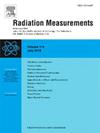石墨量热法测定同步辐射动态扫描4T摆动光束的绝对剂量
IF 2.2
3区 物理与天体物理
Q2 NUCLEAR SCIENCE & TECHNOLOGY
引用次数: 0
摘要
石墨量热法先前已被确定为在澳大利亚同步加速器的成像和医疗光束线(IMBL)上确定传递给动态扫描样品的吸收剂量的主要方法。此后,波束线将摆动器可以工作的最大场从3T增加到4T,从而改变了光谱输出和显着提高的剂量率(高达约6000 Gy/s)。我们使用石墨量热计和计算来确定这些新光束对水的吸收剂量,并将结果与PTW 31014针尖室和两个PTW 31022 3D针尖室的测量结果进行比较,这两个针尖室都是在传统的x射线光束中校准的。结果与传统的x射线校准在一定范围的滤光率下是一致的。我们的结论是,目前的剂量测定方案与精确电离室是合适的,在新的摆动场。本文章由计算机程序翻译,如有差异,请以英文原文为准。
Absolute dosimetry on dynamically scanned 4T wiggler beams for synchrotron radiotherapy using graphite calorimetry
Graphite calorimetry has previously been established as a primary method for determining the absorbed dose delivered to a dynamically scanned sample in the Imaging and Medical Beamline (IMBL) on the Australian Synchrotron. The beamline has since increased the maximum field at which the wiggler can operate from 3T to 4T, resulting in changed spectral output and significantly higher dose rates (up to around 6000 Gy/s). We use the graphite calorimeter and calculations to determine the absorbed dose to water delivered by these new beams and compare the results with measurements from a PTW 31014 Pinpoint chamber and two PTW 31022 3D Pinpoint chambers, which were all calibrated in conventional x-ray beams. The results are in good agreement with the conventional x-ray calibrations for a range of filtrations. We conclude that the current dosimetry protocol with pinpoint ionization chambers is appropriate at the new wiggler field.
求助全文
通过发布文献求助,成功后即可免费获取论文全文。
去求助
来源期刊

Radiation Measurements
工程技术-核科学技术
CiteScore
4.10
自引率
20.00%
发文量
116
审稿时长
48 days
期刊介绍:
The journal seeks to publish papers that present advances in the following areas: spontaneous and stimulated luminescence (including scintillating materials, thermoluminescence, and optically stimulated luminescence); electron spin resonance of natural and synthetic materials; the physics, design and performance of radiation measurements (including computational modelling such as electronic transport simulations); the novel basic aspects of radiation measurement in medical physics. Studies of energy-transfer phenomena, track physics and microdosimetry are also of interest to the journal.
Applications relevant to the journal, particularly where they present novel detection techniques, novel analytical approaches or novel materials, include: personal dosimetry (including dosimetric quantities, active/electronic and passive monitoring techniques for photon, neutron and charged-particle exposures); environmental dosimetry (including methodological advances and predictive models related to radon, but generally excluding local survey results of radon where the main aim is to establish the radiation risk to populations); cosmic and high-energy radiation measurements (including dosimetry, space radiation effects, and single event upsets); dosimetry-based archaeological and Quaternary dating; dosimetry-based approaches to thermochronometry; accident and retrospective dosimetry (including activation detectors), and dosimetry and measurements related to medical applications.
 求助内容:
求助内容: 应助结果提醒方式:
应助结果提醒方式:


